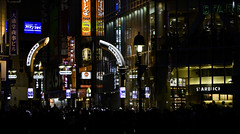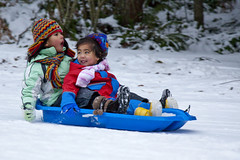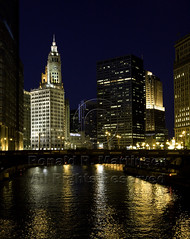Thank you for joining me in this first “roundup” series. Please comment on these articles if you enjoyed this format and I’ll consider doing more in the future (in fact, one on web hosting sites is in the works). To recap, the following articles were part of this review:
Image Processing Results
In this section I will discuss how each product faired using its default settings on each of the 4 test photos, and awards points for their performance (the more the better). To best view the results, you MUST view them at 100% as the scaled versions shown inline have compression artifacts that keep them for showing the exact results (they are close, but 100% are significantly better). I also award points for the results achieved by the software developers of each product and how they processed the photo, as I assume this to be the theoretical best results you could expect to get.
It is worth noting that noise reduction results are SUBJECTIVE. This means that my rankings may not correspond with your as you may place a higher value on edge preservation than I do, or you might expect zero noise in the final image at all cost. Use these results as a starting point, but I encourage you to experiment with trial version of each product to determine your own winner. When you do, please be sure to post your results on my flickr group so that you can enter to win a FREE copy of your favorite product in our contest. 4 copies of EACH of Noiseware, Noise Ninja and Dfine (12 total) will be given away!
Methodology
To accurately evaluate these photos you MUST click them and view them at 100%.
- The way I created these was by opening the CR2 RAW image into Adobe Photoshop CS4 (11.0.1) via Adobe Camera Raw 5.3.0.21 on 32-bit Microsoft Windows Vista SP1 system as a 8-bit sRGB image.
- For the original, I set the Noise Reduction Luminance and Color from the details tab to 0. I then did a New Smart Object via Copy to create a new layer copy that has its own independent Adobe Camera Raw settings (duplicate layer just links to the original). I named this layer ACR.
- I duplicated the above layer and then chose Rasterize Layer to prevent it from being a smart object, and I named this layer Photoshop.
- I duplicated this layer twice and called those layers Noise Ninja and Noiseware. At this point, ALL layers are still exact copies of the original layer and NO filters have been run.
- I ran the Dfine filter on one of these original layers because it always creates its own new duplicate layer before performing any changes (a feature I love and wish ALL destructive plug-ins did). When running filters for this test (except ACR/Lightroom), I simply run the filter and click ok to close it on its appropriate layer. I don’t make any changes because I’m wanting to compare the out of box experience that you would get.
- I repeat this process for all of the other filters. For Noise Ninja I do click the Profile Image button, and for Noiseware I selected the Default “setting” for the Sledding photo, and Night Scene for the others as I expect that would be what any reasonable person would do when experimenting with these products. Noise Ninja also has the benefit of custom camera profiles I created that it detects and uses to assist in its processing accuracy (see the Noise Ninja review for the difference it makes).
- For Lightroom, I actually used Adobe Camera Raw (ACR) as they use the same code behind the scenes and my testing couldn’t detect a difference between the products. I had previously processed all of these images in Lightroom with some level of noise reduction, so I simply used the values I had set by hand when I originally processed these photos. In some cases, like Chicago, that was just Lightroom 2’s default noise reduction setting.
- I then did a 1 inch x 1 inch @ 240 dpi crop of an area I deemed to be the most noisy, and saved the PSD.
- Finally I did a select all of this square and did a copy, followed by a paste into a new 3 x 2 inch 240 dpi sRGB target document. I repeated this process for each layer, with the layer in question being the only selected and visible layer at the top I do my copy.
This photo was probably the most noisy picture of this roundup. In looking at the results, I was unimpressed with the default experience I got from Photoshop, but it could easily be argued that with a better knowledge of this tool and isolating the changes to only a specific channel I could get better results. However, this was about the default experience and I wasn’t happy with the results I got. In fact, through this article you will see that the results I got in Photoshop using its Reduce Noise filter is simply unacceptable. You’ll also notice that ACR/Lightroom does a decent job of getting rid of the noise, but at the cost of softening the detail of the edges in the image. Noise Ninja seems to favor edge detail preservation and takes a less aggressive default processing, but you are free to tweak that if you want (as I demonstrate with all three of the products in their respective articles thanks to the assistance of a developer from each product). In this image, I found the results from Noiseware to be the most impressive as it maintained nearly as much edge detail as Noise Ninja, yet just a little more noise was eliminated over Dfine.
For this image, I award the following points (more is better):
- Imagenomic Noiseware 4.1.1 (WINNER) - 5
- Nik Software Dfine 2.0 - 4
- PictureCode Noise Ninja 2.x - 3
- Adobe Lightroom 2.3 / Adobe Camera Raw (ACR) 5.3 – 2
- Adobe Photoshop CS4 - 1
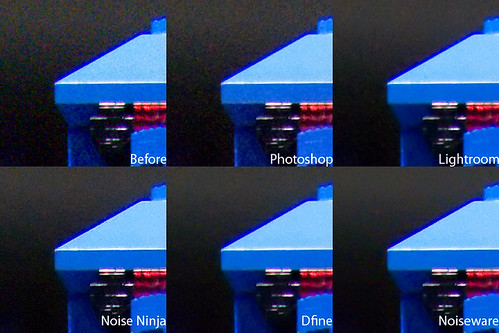
When the software developers worked on this photo, I felt that David clearly got the best balance of noise reduction and sharpness, followed by Fernando who had an edge on noise reduction at the top of the image. The result by Josh actually felt like a step backwards from the auto default results.
Software Developer Shootout Results (click the name to see their processed image):
- David (Imagenomic) - Winner –5 Points
- Fernando (Noise Ninja) – 4 Points
- Josh (Dfine) – 3 Points
This photo was the one that most easily hid the noise, and in fact I’ve printed it and didn’t really even notice the noise before this roundup. However, upon close inspection I see that the well lit back corner of this image features some serious noise. Again, Photoshop was pathetic and ACR/Lightroom was just kills the detail in the image. Noise Ninja once again does a great job with detail via less aggressive noise reduction creating results that honestly would print very well. However, I still felt that Dfine maintained a similar level of edge detail, yet it reduced significantly more noise than Noise Ninja. Once again Noiseware offered the most impressive balance of noise reduction and edge preservation (although you MUST click to view the 100% image to see that difference as the image below shows more detail in Noise Ninja).
For this image, I award the following points (more is better):
- Imagenomic Noiseware 4.1.1 (WINNER) - 5
- Nik Software Dfine 2.0 - 4
- PictureCode Noise Ninja 2.x - 3
- Adobe Lightroom 2.3 / Adobe Camera Raw (ACR) 5.3 – 2
- Adobe Photoshop CS4 - 1
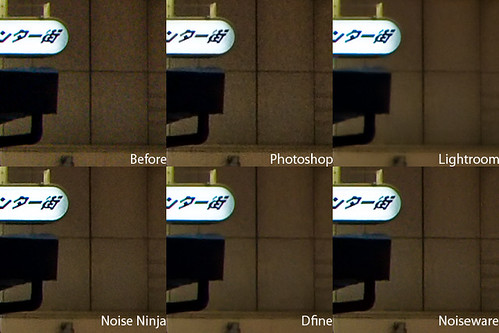
When the software developers worked on this photo, I felt that Josh clearly got the best balance of noise reduction and sharpness – especially when you look at the back wall used in the 100% crops above. A very close second was Fernando, but he has just a tad too much noise. David’s results were disappointing as his got rid of the noise but at too much of a cost to detail loss, so I thought the default results were much better.
Software Developer Shootout Results (click the name to see their processed image):
- Josh (Dfine) – Winner - 5 Points
- Fernando (Noise Ninja) – 4 Points
- David (Imagenomic) - 3 Points
This image suffers from a bit of camera shake in addition to noise. It should be noted here that the might 5D Mark II’s infamous noise reduction ONLY occurs on the JPEG images, so if you shoot raw you don’t see those results unless you develop your RAW images in Canon’s own Digital Photo Professional 3.5.1.0. Click here to see what DPP’s processing of this RAW image – it’s quite impressive. I chose not to include it in this round up since I don’t believe that DPP is going to be a part of most people’s natural workflow, but Lightroom or Adobe Camera Raw will be.
In this case, I found it a lot harder to call a winner as none of them did an especially good job in my opinion. Of course, Photoshop sucked once again, but the softness of ACR/Lightroom actually works on this photo. Noise Ninja’s definitely creates the fewest artifacts around the bridge of the nose which would likely result in the best printing experience. However, it is just too close to call for Dfine and Noiseware, so I’m going to declare this one a tie between them and I am going to award an extra point to Noise Ninja as printing might give it an edge in this case.
For this image, I award the following points (more is better):
- Nik Software Dfine 2.0 – (CO-WINNER) - 5
- Imagenomic Noiseware 4.1.1 - (CO-WINNER) - 5
- PictureCode Noise Ninja 2.x – (SPECIAL AWARD) 4
- Adobe Lightroom 2.3 / Adobe Camera Raw (ACR) 5.3 – 2
- Adobe Photoshop CS4 - 1
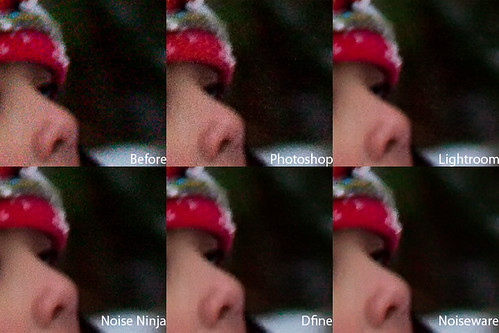
When the software developers worked on this photo, I felt that Josh clearly got the best balance of noise reduction and sharpness – especially when you look at the greenery and the detail in the older girls hat. A very close second was David, as his results were almost as good. Fernando’s was a bit softer with a little more noise.
Software Developer Shootout Results (click the name to see their processed image):
- Josh (Dfine) – Winner - 5 Points
- David (Imagenomic) - 4 Points
- Fernando (Noise Ninja) – 3 Points
This image seemed to benefit the most from noise reduction as it cleans up quite nicely. In this test, even the pathetic Photoshop seems to yield a nice improvement, and Lightroom does a very good job. When I ran Noise Ninja, I was blown away and I thought for sure it would be the clear winner. It got rid of the noise, yet maintained excellent detail on the area around the clock. Next, I ran Dfine and my jaw dropped! It looked great, but it did lose some detail on the tick marks of the clock so its actually a little softer than ACR/Lightroom. Finally, the results from Noiseware were once again a great balance of noise reduction and edge preservation, and at 100% it is the clear winner in this roundup. It is a tad software on the edge around the clock, but when you view this at 100% you’ll see that the clock details and smoothness in the sky clearly favors Noiseware.
For this image, I award the following points (more is better):
- Imagenomic Noiseware 4.1.1 (WINNER) - 5
- PictureCode Noise Ninja 2.x - 4
- Adobe Lightroom 2.3 / Adobe Camera Raw (ACR) 5.3 – 3
- Nik Software Dfine 2.0 - 2
- Adobe Photoshop CS4 - 1
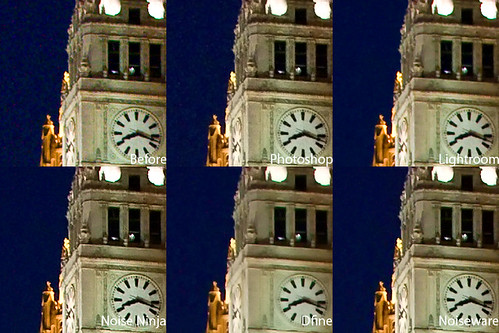
When the software developers worked on this photo, the results were quite different. I felt that Fernando clearly got the best balance of noise reduction and sharpness, followed by Josh who had an edge on detail in the water. The result by David was good, but not as good as the others.
Software Developer Shootout Results (click the name to see their processed image):
- Fernando (Noise Ninja) – Winner – 5 Points
- Josh (Dfine) – 4 Points
- David (Imagenomic) - 3 Points
User Interfaces
My day job for the last 15 years at a major software vendor as been as a user-interface (UI) developer. To me a successful user interface is one that can take advantage of the key features of the product without you ever having to read a manual. In this roundup, I define that as Ease of Use and award 5 points for the winner. Photoshop and ACR/Lightroom are not included as the results of the noise reduction test make me feel like they are not serious competitors in this space and they have no mathematical chance of winning this roundup, so they are excluded from this portion. With that, here are my user interface rankings:
User Interface Third Place - Noiseware (Ease of Use - 4 points, Features – 3 points)
All products were easy to use, but Noiseware stood apart from the others in that its best results were obtained by the default results – that’s impressive! If I were batch processing a large group of images, there’s no doubt that this is the product that I would use. As you saw previously, its default results back up that statement! That said, once you get past the Settings dropdown and Noise Reduction sliders, this is a pretty intimidating user interface. A typical user will be baffled at the choices in the Detail, Frequency, etc… tabs, and the graph in the bottom right offers eye candy, but no obvious value. One a positive note, it is probably the fastest UI of the bunch, so if performance were a category it would win hands down.
 User Interface Second Place - Noise Ninja (Ease of Use - 3 points, Features – 5 points)
User Interface Second Place - Noise Ninja (Ease of Use - 3 points, Features – 5 points)
Noise Ninja is clearly targeted to the person who wants full control over everything this product does. It’s chock full of features and that’s both good and bad. My experience tells me that all this detail will be intimidating to most, and its requirement to click the Profile Image is perplexing. Of the products in this roundup, this is the only one that required me to read the manual to use it effectively, and even then I didn’t feel comfortable making certain adjustments (like the Turbo & Coarse noise checkboxes – huh?). It’s noise brush is a great idea as it allows you to say “hey, don’t apply noise reduction here”, which would be real useful for the clock tower on Chicago. It also is the only product to offer the ability for you to create camera profiles to ensure that you’ll get the best possible results with your camera and lenses. If you master this product, you have the ability to create your OWN definition of perfect noise reduction results based on your own balance of detail preservation and noise removal. It is for these reasons, that I feel that feature-wise this is the strongest product here – by far.

User Interface First Place - Dfine (Ease of Use - 5 points, Features – 4 points)
I love Nik Software products because they just work and are very easy to use. Sure, they have little quirks with the horrible way they do zooming, and they lack the proper shortcut keys to switch between the hand and zoom, but its U-Point technology gives you the ability to create complex masks and you’ll never have to know you are even using masks. In addition, its default experience is simple and highly effective. This is how user-interface should be done because it is simple and hides the gory details from you, but if you want more control then you simply go to manual mode and party with your U-Point controls. This product is a pleasure to use, and I frequently find myself using it now when I know I’m going to want to exclude noise reduction in a specific area of my image. It does lack the power of Noise Ninja, so I can’t help but dock a point there. However, it offers more practical features than Noiseware, so while it doesn’t seem as “scientific”, I think it clearly offers more control over features people will actually use to get superior results.

Ranking the Noise Reduction software products, and the Winner is…
Noise reduction is always a trade-off because reducing noise comes at the expense of losing image detail. How much noise reduction you apply is strictly based on how much detail you want to lose, and all of these products let you control that balance. This means that the real winner here is very subjective because what might be excellent for me, might be too much loss of detail for you. As a result, I encourage you to keep your needs in mind and install the free trial versions of these products to see which is right for you.
With that said, I hate articles that are like lawyers who never give you a straight answer or recommendation. I am going to draw a line in the sand and give you the order in which I think the products fell based on how I would use these products. This means I place a high value on the out of box experience and the ease at which I can use the product (without reading manuals) to tweak those default settings if I think they are too aggressive.
The final order, from worst to best, in this round-up is:
5. Adobe Photoshop CS4’s Reduce Noise Filter – Given the cost of Photoshop, and its complex upgrade rules, it is embarrassing that this is the best that they can do with Noise Reduction. This type of round up shouldn’t be necessary as Adobe should have a great built-in solution, but they don’t. If you have to do Noise Reduction in Photoshop, my recommendation is that you do it in Adobe Camera Raw as that is what Lightroom uses, and you will get much better results.
4. Adobe Lightroom 2.3 / Camera Raw 5.x’s Noise Reduction feature – Lightroom is really just Adobe Camera Raw on steroids, so you can consider the results here applicable to both products. It does a reasonable job of getting rid of noise, but it kills the detail (which you can recover marginally with sharpening, but not enough). It’s much better than what you get in Photoshop, so that’s good, but for me I’d rather any of the products below more than this.
3. PictureCode Noise Ninja (38 points) – Before this round-up, this was the product I had purchased and used regularly as it has long been known as the most popular product used by the pros. I was happy with the results and thought it was a good product, but the user-interface isn’t as friendly as some of the others here. In real-world use, if it didn’t give me the results I desire, I would do selective noise reduction using masks or on a single channel (usually the blue channel) only. If you want the most advanced noise reduction solution which offers ultimate control via camera profiling, then nobody in this round up can touch Noise Ninja – period. However if you want to make the most of this product then plan on learning what all of those controls in Noise Ninja do, and ordering a camera calibration chart from PictureCode to create profiles specific to your camera. This will mean a significant time investment up front on your part, but in the end it will give you the greatest control over reducing noise without losing detail of any product here.
2. Nik Software Dfine (41 Points) – If you’ve followed my blog, you know that I have recommended every Nik software product I’ve tested. The reason why is simple – they make great software that offers outstanding default results which can easily be tweaked using their revolutionary U-Point controls. The automatic results I got with Dfine were near identical to Noiseware, yet selectively applying those results using U-Point controls or the brush feature made it much easier to control the final image that I could be happy with. In addition to all of this, Nik offers videos on their site and webinars that offer you a chance to see the product in action in the hands of Nik’s imaging gurus. While Dfine lacks the fine level control of Noise Ninja, and some of the advanced features of Noiseware, it offers enough control for my needs and provides results that I am very happy with. As a result, when doing noise reduction I’ll always try this product first to see if I can get the results I want, before I try out the others. However, when I total all the points Dfine falls a point short due to its default performance on the Chicago image. It’s default processing was consistently a little softer than Noiseware’s, so I have to give it a second place but only by a hair. If you already own this product, then stick with it.
A 15% discount on all Nik Software is available for readers of this blog by entering the code rmartinsen when you order online or call to place an order. This offer excludes 3rd party software, bundles and upgrades, but even if you buy an excluded product please include the code when ordering.
1. Imagenomic Noiseware (42 points) – This is the product of choice recommended by Photoshop guru, Scott Kelby. I hadn’t heard about this product until he mentioned it in one of his books, and I’ll admit that my expectations for it were low. After all, Noise Ninja was king in my book, so how could this product compete with that? Well, the reality is that this product blew me away and yielded out of box results that knocked my socks off. This is how the default noise reduction should be done in my book, so it is very easy to recommend this product. The user-interface offers lots of powerful adjustments, similar to Noise Ninja, but it offers some ease of use features like its settings list which allows you to select some common user scenarios and get a new automatic result. I wish it had a noise brush or U-Point controls to help with selective noise reduction, but the reality is that I can easily do that myself with a layer mask (as I typically did with Noise Ninja in the past).
Use the following links to order your copy of Noiseware today. Be sure to enter the coupon code RONMART when you check out for a 15% discount on the following versions:
Conclusion
While Photoshop and Lightroom give you something that is better than nothing, the real players in this game are Noise Ninja, Noiseware, and Dfine. All are great products in their own way, and I would encourage you to experiment with their trial versions to figure out which is right for you. When you do, enter your test photos into the Greatest Saves Contest for a chance to win one of 12 free copies of the top 3 products (4 copies for each product) being given away.
Hopefully you’ve enjoyed this series as much as I have. If you are like me this will save you a lot of money because you are now better prepared to make an intelligent purchase. If this is the case, then please help support this blog by:
- Purchasing one of these products using the links in this article,
- sharing this article with all of your friends,
- and save it in your favorites for future reference.
If the support for this article is positive, then look for more cool round-ups like this in the future! I’d love to hear your thoughts on this article, so comments are greatly appreciated!
Other Products (UPDATE: July 20, 2009)
Since I originally wrote this article, I had the chance to try out another product – DeNoise 3 by Topaz Labs. Several readers of this article had commented about it, and while I was very unimpressed with version 2, version 3 was an improvement. I still stick by my existing recommendations here and would Topaz Labs Denoise 3 right behind PictureCode’s Noise Ninja.
NOTE: This site requires cookies and uses affiliate linking to sites that use cookies.
. Either way, your support is greatly appreciated!
This blog is intended for freelance writing and sharing of opinions and is not a representative of any of the companies whose links are provided on this site.
The opinions provided are of Ron Martinsen alone and do not reflect the view of any other entity























